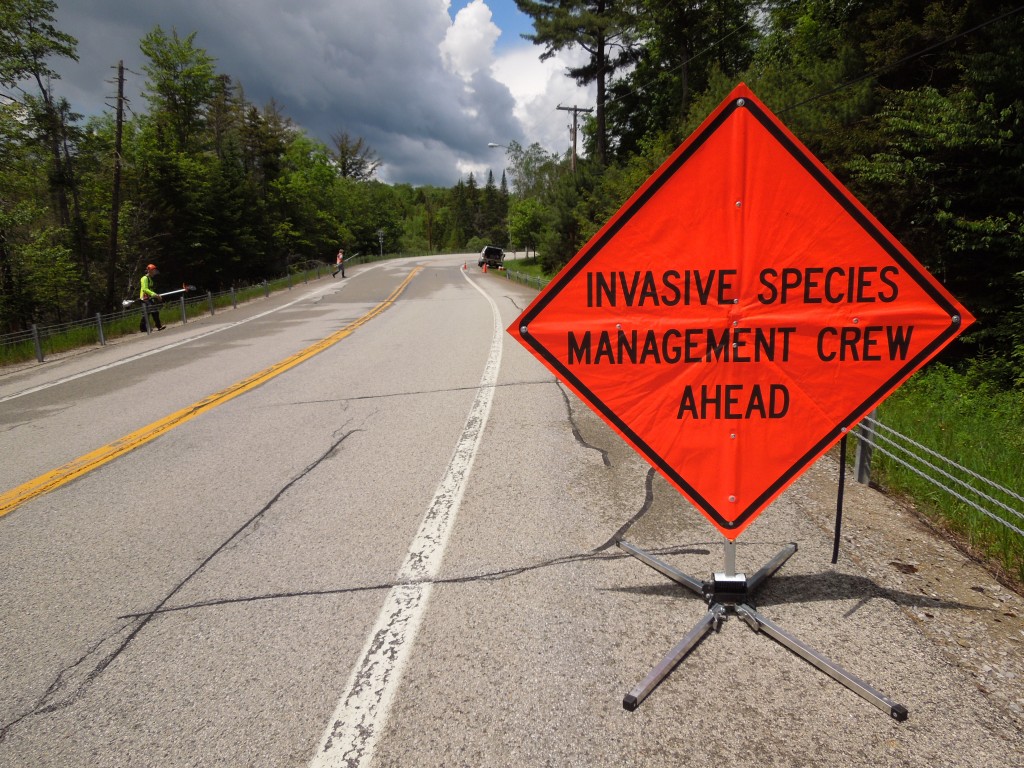 Brendan Quirion, of the Nature Conservancy, shares details about the Adirondack Park Invasive Plant Program.
Brendan Quirion, of the Nature Conservancy, shares details about the Adirondack Park Invasive Plant Program.
What aspects of Phragmites management are you most involved in?
- Education and outreach
- Direct management (e.g. spraying, burning)
- Planning
What geographic scope does this project cover?
The six million acre Adirondack Park in upstate New York, as well as the northern portions of Franklin and Clinton Counties to the U.S. border. This area makes up the Adirondack Partnership for Regional Invasive Species Management (PRISM).
Why is Phragmites an issue in your area?
Approximately 10% to 12% of the land cover in the 6 million acre Adirondack Park is comprised of wetlands. Many represent some of the largest, most intact examples in the Northeast. Phragmites is just making inroads into the interior Adirondacks, which poses a significant threat to these ecosystems while also providing an opportunity for true early detection and rapid response at a landscape scale. Mapping efforts have shown that the average patch size of a Phragmites infestation within the interior Adirondacks is under one tenth of an acre in size prior to treatment. Since 2010, out of 131 Phragmites patches managed, 37% already have no Phragmites observed as of 2012, exceeding our expectations of effective control within such a short timeframe. The first successful complete elimination (3 consecutive years of no plants observed) of a Phragmites infestation is expected to be documented in 2013.
What is your organization’s approach to invasive Phragmites management?
For the most part, all Phragmites management is conducted via herbicide treatment. Treatments are conducted during or around the tasseling period when herbicide can be effectively translocated to the roots. The method of treatment used is usually a combination of a foliar spray using a backpack sprayer and cut stem injection using a stem injection gun. Stem injection is used around native vegetation to reduce off-target impacts, for patches with low stem density, and on spray lanes that are cut through patches that are large and dense. The herbicide product most commonly used is Aquamaster. The year after treatment, dead Phragmites stems are mowed down to stimulate native plant recovery in the once invaded site. Prior to implementation, this project was run through The Nature Conservancy’s Invasive Plant Management Decision Analysis Tool (IPMDAT) in order to help ensure that the project was feasible and would result in clear conservation benefits that outweighed the associated cost.
Who are your partners in this effort?
Primary partners include The Nature Conservancy, New York State Department of Environmental Conservation, New York State Department of Transportation, and New York State Adirondack Park Agency. We also have 30+ other cooperating organizations and hundreds of volunteers.
What are your funding sources?
Primary funding for the Adirondack Park Invasive Plant Program (APIPP) comes through New York State’s Environmental Protection Fund (EPF). Funding for priority projects like the rapid response team which has been utilized in the park since 2011 has come from private grants and donations.
What are you goals and objectives for the program?
Our goal is to eliminate (3 consecutive years of no plants observed) at least 90% of all of the Phragmites infestations within the interior Adirondacks by 2020. At the same time we hope to increase awareness through education and outreach among the general public and our partners about Phragmites and other harmful invasive species, how they are spread, best management practices, and opportunities to mitigate impacts.
What type of land does your program target?
Wetlands, roadsides, forest preserve (forest preserve is public land protected as forever wild), stream corridors, and sometimes private property.
What is the status of the program and are you seeing results?
We are well on our way. Out of 131 Phragmites sites treated since 2010 utilizing our rapid response team, 37% of them are already at their first year of having no invasive plants observed. Steep declines in both gross acreage and percent cover have been documented using the program’s weed information management system (WIMS) database. Photo monitoring of all sites has also been conducted to document success. It is expected that the first successful elimination (3 consecutive years of no plants observed) of a Phragmites patch in the interior Adirondacks will be documented in 2013.
Can you share important lessons learned both about what worked and what has not worked?
– Except for extremely small sites, herbicide treatment is necessary to achieve successful elimination.
– Cut stem injection is extremely effective and reduces off target impacts significantly.
– Early detection and response is critical to completely eliminate sites. Threshold for elimination seems to be around less than 1 acre based on preliminary results.
– Treatments conducted late in the field season can be extremely successful, even up to just a couple weeks before the first hard killing frost.
– Mowing dead stems after the 1st year of treatment helps immensely in stimulating native plant recovery.
– For small isolated sites that are adjacent to native seed source populations, native plants seem to recover on their own given time and no follow up restoration or planting is necessary.
– Cooperation with local and state highway departments is critical as they are mainly responsible for the spread of Phragmites along road corridors through mowing regimes and the movement of contaminated fill.
– Cutting larger Phragmites sites multiple times a year is not effective in achieving control and can actually make the problem worse.
– You should expect to commit at least 5 years to any Phragmites management project as pesky resprouts often need to be retreated and follow-up monitoring is necessary.
– Extensive survey efforts can expect to find Phragmites plants in larger sites even after native plants have begun to recover.
For more information check out the project website, look at this presentation, or contact
Brendan Quirion
Terrestrial Invasive Species Project Coordinator for the Adirondack Park Invasive Plant Program (APIPP)
bquirion@tnc.org
518-576-2082
